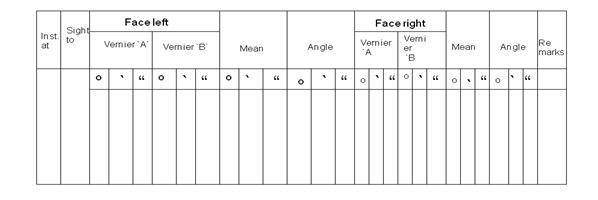THEODOLITE LESSON 5
HORIZONTAL ANGLE
•
When two lines are meeting on a horizontal plane the
angular distance between them is called “horizontal angle”
• These angles are measured with help of horizontal
(plate) circle and corresponding verniers “A” and “B”
MEASUREMENT
OF HORIZONTAL ANGLE
•
By the method of repetition
•
By the method of reiteration
REPETITION METHOD
•
This method is adopted for precise works
•
Face left and face right observations are essential
•
All the readings should be entered in field book
STEPS INVOLVED IN MEASURING HORIZONTAL ANGLES
Let “O” is an instrument station
“P” and “Q” are objects
( see Figure- 2 (a) and
(b)
•
Set up theodolite over station “O” and complete the
temporary adjustments accurately
•
Bring the vernier “A” to zero degrees
•
Release lower clamp screw and sight to object “P” and
clamp it firmly
•
Bisect the object “P” accurately with help of corresponding slow motion screw
•
Release the upper clamp screw and sight to
object “Q” and clamp it
•
Bisect the
object “Q” accurately with help of corresponding
slow motion screw
•
Read main
scales and corresponding vernier scales “A”
and “B”
•
Enter the
readings in the proforma shown in table -1
•
Take average
of two readings. This reading is the required horizontal angle “POQ”
•
Change the
face of the instrument, repeat the process as explained above
•
Take average
of two readings. This reading is the required horizontal angle “POQ”
•
Take average
of face left and face right to get further accurate horizontal angle “POQ”
METHOD OF REPETITION
•
Measure the horizontal angle for ‘n’ no of times so
that the included angle accumulates to approximately ‘n’ times the actual
horizontal angle.
•
Divide the
total reading by ‘n’ to get accurate horizontal angle between P and Q.
The following errors are eliminated
in this method
•
The errors due
to the eccentricity of the centers and of
the verniers are eliminated by taking average of both verniers
•
Imperfect
adjustment of the line of collimation and the
horizontal axis of the telescope are eliminated by face left and face right observations
•
The errors of
graduations are minimized by measuring the angle on different parts of the
circle
•
The errors in the pointings tend to compensate each
other and the remaining error is minimized by the division
NOTE: Error due to
improper levelling of the bubble cannot be eliminated. However this can be
eliminated by perfect levelling of the instrument
REITERATION METHOD
•
This method
is used when several angles are to be measured at a point
•
This method consists of measuring several angles successively and finally closing (ending) on first station
Let
•
A,B,C,D
are objects
•
“O” is
an instrument station
•
Set up theodolite over station “O” and complete the
temporary adjustments accurately
•
Bring index of verniers “A”
to zero degrees.
•
Release lower clamp screw and sight to object “A” and
clamp it firmly.
•
Bisect the object “A” accurately with the help of
corresponding slow motion screw
•
Release the
upper clamp screw and sight to object “B” and clamp it
•
Bisect the
object “B” accurately with help of corresponding
slow motion screw
•
Read main
scales and corresponding vernier scales “A”
and “B”
•
Enter the
readings in the proforma shown in table -1
•
Release the
upper clamp screw and sight to object “C” and clamp it
•
Bisect the
object “C” accurately with help of
corresponding slow motion screw
• Read main
scales and corresponding vernier scales “A” and “B”
• Enter the
readings in the profarma shown in table -1
•
Repeat the
process until all objects are completed
•
Enter the
respective readings in the profarma shown in
table -1
•
Change the
face of the instrument and repeat the process
as explained above
• Take average
of face left and face right to get further accurate respective angle
The following errors are eliminated
in this method
•
Graduation
errors are eliminated
•
The errors due to the eccentricity of the centers and
of the verniers are eliminated taking
average of both verniers
•
Imperfect
adjustment of the line of collimation and the horizontal axis of the telescope
are eliminated by face left and face right observations






ConversionConversion EmoticonEmoticon